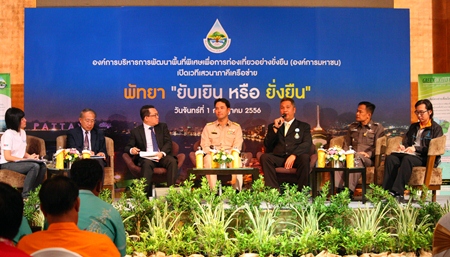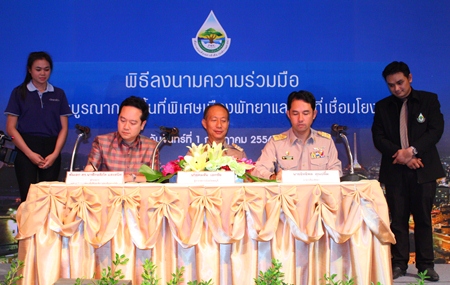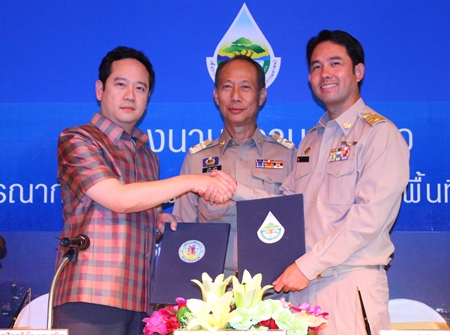The former secretary-general of Thailand’s National Economic and Social Development Board called four proposed tunnels under busy intersections on Sukhumvit road a “waste” of investment and destructive to Pattaya’s environment.
Speaking at the fourth Designated Areas for Sustainable Tourism Administration public hearing on a 15 billion baht sustainable-tourism “master plan” for the Pattaya region July 1, Suwat Waneesubut, now an independent “expert” on traffic solutions, called Mayor Itthiphol Kunplome’s tunnel-bypass proposal “inappropriate” given general population trends.
 (From 2nd left to right) Suwat Waneesubut, Thanes Supharoshasrangsee, Mayor Itthiphol Kunplome, Thaweepong Wichaidit, Pol. Col. Suwichan Yankittikul, and Jongmewsin discuss Pattaya tourism during the fourth Designated Areas for Sustainable Tourism Administration public hearing.
(From 2nd left to right) Suwat Waneesubut, Thanes Supharoshasrangsee, Mayor Itthiphol Kunplome, Thaweepong Wichaidit, Pol. Col. Suwichan Yankittikul, and Jongmewsin discuss Pattaya tourism during the fourth Designated Areas for Sustainable Tourism Administration public hearing.
“Constructing tunnels may not be a solution to traffic, would be a waste of investment and destructive to the city’s landscape,” said Suwat, noting that decreasing population growth will mean less traffic in the future. He instead suggested construction of a new highway for traffic bypassing Pattaya.
Itthiphol in 2011 proposed four subterranean tunnels running under Sukhumvit Road intersections with North, Central, South and Thepprasit roads. Planning has already begun on all four bypasses, which measure 1,000-2,000 meters long.
“A well-functioning city is one with 15-20 percent of its area devoted to traffic flow. Pattaya has only 3.5 percent allocated to traffic,” Suwat said. “Therefore a bypass road has to be constructed for people not wanting to pass through the heart of Pattaya and decrease the number of cars on Sukhumvit Road.”
Combined with outlying parking lots and public transit, traffic problems could be resolved in the city, he added.
The provocatively named “Pattaya: Sustainable or Demolish?” hearing at the Amari Orchid Resort & Tower took testimony from urban and environmental consultants, police, tourism and city officials on the DASTA “master plan” approved in August 2011. It called for 15 billion baht in funding over 10 years for 132 projects in Pattaya and nine surrounding districts.
Very little of the plan has been implemented, as national politicians have shown little enthusiasm to fund the long list of pork-barrel projects largely suggested by Itthiphol. Last year, the Cabinet axed 56 projects and cut the total package by 38.5 percent to 9.2 billion baht over eight years.
In 2012, the government gave Pattaya only 135 million baht of the 15 billion baht plan – about 1 percent. For 2013, the government allocated only 299 million baht of the reduced packaged, or about 3 percent of funds requested.
“Pattaya’s focus on financial development has led to decreased emphasis on the environment and society,” said environmental consultant Somnuk Jongmewsin, who said pollution in Pattaya is the most-obvious symptom of that environmental neglect.
“The amount of waste and the availability of areas to accommodate that waste are not in balance, partly because the city has turned those areas into tourism destinations, industrial developments and construction sites for buildings,” Somnuk said.
The result has been inefficient trash collection and water consumption that has left areas of the city with scarcity problems, he said.
“If these issues are not addressed seriously within the next two years, when the ASEAN Economic Community begins, they will affect development of the economy and tourism, leading to Pattaya’s demolishment,” Somnuk said.
Set up by a 2003 royal decree, DASTA was given a mission to integrate and oversee tourism development in areas designated to have superb natural environments, cultural and traditional importance and have been developed for tourism purposes.
With its sprawling nighttime industry and many environmental problems, Pattaya’s bids for DASTA status – and the millions in baht that come with it for mayoral pet projects – were repeatedly turned away. But in July 2008 Bangkok officials conceded, admitting Pattaya formed a “distinctive” area for international tourism and could retain its status as a draw for foreign currency if developed properly.
Thus began more than three years of discussions and proposals that culminated in 29 public hearings and private meetings and the March 2009 designation of a 928 sq. km. zone comprising Pattaya and the eight districts.
At the latest hearing, Itthiphol strove to defend his remaining 76 projects in the face of the consultant’s stinging criticism.
He maintained that, once the AEC opens, Pattaya will be able to accommodate 10 million tourists a year – with the help of the nine other districts.
“All nine local organizations must support each other and cooperate to see DASTA’s 76 projects completed,” the mayor said. “They will help Pattaya grow and I believe the city will have stability in finances, tourism, environment and transportation if all sectors work together.”
Surprisingly, Itthiphol got a vote of confidence from Thaweepong Wichaidit, manager for the Pattaya Special and Adjacent Areas Office.
Thaweepong, who last September called many of the mayor’s projects “low in potential,” under the jurisdiction of other agencies, and incongruent with the goal of developing the area for “green” tourism, said he saw effort by city hall to corral problems with garbage, wastewater and community involvement.
“Pattaya has given priority to a community created by residents and inform them of local issues and what must be fixed,” Thaweepong said.
In another effort to restore confidence in his proposals, Itthiphol used the hearing as occasion to sign yet another in a long line of “memorandums of understanding” with DASTA and Banglamung District.
Like earlier agreements signed over the past two years, the latest pact reaffirms a commitment to cooperate on restoring and managing the environment in tourist areas, particularly in garbage disposal, traffic, wastewater management, maintenance of culture and tradition, and developing Pattaya to have a sustainable tourism-based economy.






